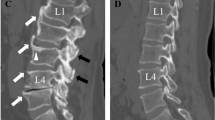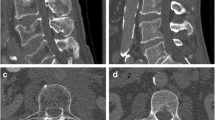Abstract
Objective
To obtain the cortex and cancellous parameter of the vertebral bone of healthy subjects using QCT. To explore which is earlier or faster for bone loss with age.
Materials and methods
733 physical examiners underwent chest low-dose CT examination were recruited, from April 1, 2021 to October 1, 2021. QCT sequence was used to obtain the bone mineral density of T12-L2 vertebral body without additional radiation. The mass and area of vertebral cortex and cancellous at the central level of L2 vertebral body were measured. The age -related characteristics of vertebral cortex and cancellous between male and female was analyzed and compared.
Results
The vBMD of T12-L2 vertebral body decreased with age. Significant differences were found in volumetric bone mineral density (vBMD) of T12-L2 vertebral body. For female, significant differences were found in bone content involving cortical mass, cancellous mass, cortical area, cancellous area, cortical mass/cancellous mass and cortical area/cancellous area in different age groups, respectively. The cortical mass decreased with age in female. The cancellous mass of female increased and then decreased with peak at 31–40 y. The cortical area of female decreased gradually before 71 y. The cancellous area of female increased and then decreased with peak at 51–60 y. The values of mass ratio and area ratio in female showed a slowly downward trend with age. Significant differences of bone content between non-menopausal and menopausal women were found except the cancellous mass. For male, no significant differences were found in all parameters of bone content.
Conclusion
The changes of vertebral BMD, bone content of cortex and cancellous have different characteristics in different age. The change of cortex in female maybe earlier and faster than that of cancellous, especially in menopausal women.







Similar content being viewed by others
References
Y. Zhang, J. Guo, Y. Duanmu, C. Zhang, W. Zhao, L. Wang, X. Cheng, N. Veronese, F.P. Cafarelli, G. Guglielmi, Quantitative analysis of modified functional muscle-bone unit and back muscle density in patients with lumbar vertebral fracture in Chinese elderly men: a case-control study. Aging Clin. Exp. Res. 31(5), 637–644 (2019)
M. Lopez Picazo, A. Magallon Baro, L.M. Del Rio Barquero, S. Di Gregorio, Y. Martelli, J. Romera, M. Steghofer, M.A. Gonzalez Ballester, L. Humbert, 3-D Subject-Specific Shape and Density Estimation of the Lumbar Spine From a Single Anteroposterior DXA Image Including Assessment of Cortical and Trabecular Bone. IEEE Trans. Med Imaging 37(12), 2651–2662 (2018)
J.E. Adams, Quantitative computed tomography. Eur. J. Radiol. 71(3), 415–424 (2009)
X. Cheng, K. Zhao, X. Zha, X. Du, Y. Li, S. Chen, Y. Wu, S. Li, Y. Lu, Y. Zhang et al. Opportunistic screening using low-dose CT and the prevalence of osteoporosis in China: a nationwide, multicenter study. J. Bone Min. Res. 36(3), 427–435 (2021)
P. Wang, W. She, Z. Mao, X. Zhou, Y. Li, J. Niu, M. Jiang, G. Huang, Use of routine computed tomography scans for detecting osteoporosis in thoracolumbar vertebral bodies. Skelet. Radiol. 50(2), 371–379 (2020)
X. Cheng, K. Li, Y. Zhang, L. Wang, L. Xu, Y. Liu, Y. Duanmu, D. Chen, W. Tian, G.M. Blake, The accurate relationship between spine bone density and bone marrow in humans. Bone 134, 115312 (2020)
A.G. Kulkarni, Y. Thonangi, S. Pathan, S. Gunjotikar, P. Goparaju, I. Talwar, S. Jaggi, S. Shah, N. Shah, G. Kursija, Should Q-CT be the gold standard for detecting spinal osteoporosis? Spine 47(6), E258–E264 (2022)
C. Mann, K. Ziegeler, J. Mews, M. Plaschke, A.S. Issever, Bone mineral density assessment using iterative reconstruction compared with quantitative computed tomography as the standard of reference. Sci. Rep. 8(1), 15095 (2018)
Y.W. Kim, J.H. Kim, S.H. Yoon, J.H. Lee, C.H. Lee, C.S. Shin, Y.S. Park, Vertebral bone attenuation on low-dose chest CT: quantitative volumetric analysis for bone fragility assessment. Osteoporos. Int. 28(1), 329–338 (2016)
Y. Wu, Y. Jiang, X. Han, M. Wang, J. Gao, Application of low-tube current with iterative model reconstruction on Philips Brilliance iCT Elite FHD in the accuracy of spinal QCT using a European spine phantom. Quant. Imaging Med. Surg. 8(1), 32–38 (2018)
J. Kaiser, B. Allaire, P.M. Fein, D. Lu, A. Adams, D.P. Kiel, M. Jarraya, A. Guermazi, S. Demissie, E.J. Samelson et al. Heterogeneity and spatial distribution of intravertebral trabecular bone mineral density in the lumbar spine is associated with prevalent vertebral fracture. J. Bone Miner. Res. 35(4), 641–648 (2020)
S.S. Mao, D. Li, Y.S. Syed, Y. Gao, Y. Luo, F. Flores, J. Child, M. Cervantes, K. Kalantar-Zadeh, M.J. Budoff, Thoracic quantitative computed tomography (QCT) can sensitively monitor bone mineral metabolism: comparison of thoracic QCT vs lumbar QCT and dual-energy X-ray absorptiometry in detection of age-relative change in bone mineral density. Acad. Radiol. 24(12), 1582–1587 (2017)
K.J. Segheto, L.L. Juvanhol, C.J. Carvalho, D. Silva, A.M. Kakehasi, G.Z. Longo, Factors associated with bone mineral content in adults: a population-based study. Einstein 18, eAO4694 (2019)
Z. Shariati-Sarabi, H.E. Rezaie, N. Milani, F.E. Rezaie, A.E. Rezaie, Evaluation of bone mineral density in perimenopausal period. Arch. Bone Jt Surg. 6(1), 57–62 (2018)
G. Gutierrez-Buey, P. Restituto, S. Botella, I. Monreal, I. Colina, M. Rodriguez-Fraile, A. Calleja, N. Varo, Trabecular bone score and bone remodelling markers identify perimenopausal women at high risk of bone loss. Clin. Endocrinol. 91(3), 391–399 (2019)
N. Wu, Q.P. Wang, H. Li, X.P. Wu, Z.Q. Sun, X.H. Luo, Relationships between serum adiponectin, leptin concentrations and bone mineral density, and bone biochemical markers in Chinese women. Clin. Chim. Acta 411(9-10), 771–775 (2010)
M. Corina, C. Vulpoi, D. Brănişteanu, Relationship between bone mineral density, weight, and estrogen levels in pre and postmenopausal women. Rev. Med Chir. Soc. Med Nat. Iasi 116(4), 946–950 (2012)
Y. Bala, R. Zebaze, E. Seeman, Role of cortical bone in bone fragility. Curr. Opin. Rheumatol. 27(4), 406–413 (2015)
K. Engelke, J.E. Adams, G. Armbrecht, P. Augat, C.E. Bogado, M.L. Bouxsein, D. Felsenberg, M. Ito, S. Prevrhal, D.B. Hans et al. Clinical use of quantitative computed tomography and peripheral quantitative computed tomography in the management of osteoporosis in adults: the 2007 ISCD Official Positions. J. Clin. Densitom. 11(1), 123–162 (2008)
K. Engelke, Quantitative computed tomography-current status and new developments. J. Clin. Densitom. 20(3), 309–321 (2017)
E.F. Morgan, G.U. Unnikrisnan, A.I. Hussein, Bone mechanical properties in healthy and diseased states. Annu. Rev. Biomed. Eng. 20, 119–143 (2018)
G. Iori, F. Heyer, V. Kilappa, C. Wyers, P. Varga, J. Schneider, M. Grasel, R. Wendlandt, R. Barkmann, J.P. van den Bergh et al. BMD-based assessment of local porosity in human femoral cortical bone. Bone 114, 50–61 (2018)
R.W. Boyce, Q.-T. Niu, M.S. Ominsky, Kinetic reconstruction reveals time-dependent effects of romosozumab on bone formation and osteoblast function in vertebral cancellous and cortical bone in cynomolgus monkeys. Bone 101, 77–87 (2017)
D.C. Lee, A. Varela, P.J. Kostenuik, M.S. Ominsky, T.M. Keaveny, Finite element analysis of denosumab treatment effects on vertebral strength in ovariectomized cynomolgus monkeys. J. Bone Min. Res. 31(8), 1586–1595 (2016)
G. Schroder, B. Jabke, M. Schulze, A. Wree, H. Martin, O. Sahmel, A. Doerell, C.M. Kullen, R. Andresen, H.C. Schober, A comparison, using X-ray micro-computed tomography, of the architecture of cancellous bone from the cervical, thoracic and lumbar spine using 240 vertebral bodies from 10 body donors. Anat. Cell Biol. 54(1), 25–34 (2021)
S. Waterloo, L.A. Ahmed, J.R. Center, J.A. Eisman, B. Morseth, N.D. Nguyen, T. Nguyen, A.J. Sogaard, N. Emaus, Prevalence of vertebral fractures in women and men in the population-based Tromso Study. BMC Musculoskelet. Disord. 13, 3 (2012)
Author information
Authors and Affiliations
Corresponding authors
Ethics declarations
Conflict of interest
The authors declare no competing interests.
Ethics approval
This study was approved by the Ethics Committee of the Third Hospital of Hebei Medical University, and all participants gave informed consent before taking part.
Informed consent
Informed consent was obtained from all individual participants included in the study.
Additional information
Publisher’s note Springer Nature remains neutral with regard to jurisdictional claims in published maps and institutional affiliations.
Rights and permissions
Springer Nature or its licensor holds exclusive rights to this article under a publishing agreement with the author(s) or other rightsholder(s); author self-archiving of the accepted manuscript version of this article is solely governed by the terms of such publishing agreement and applicable law.
About this article
Cite this article
Bai, L., Li, J., Ren, C. et al. Cortex or cancellous—which is early for the decrease of bone content for vertebral body in health?. Endocrine 78, 597–604 (2022). https://doi.org/10.1007/s12020-022-03194-6
Received:
Accepted:
Published:
Issue Date:
DOI: https://doi.org/10.1007/s12020-022-03194-6




